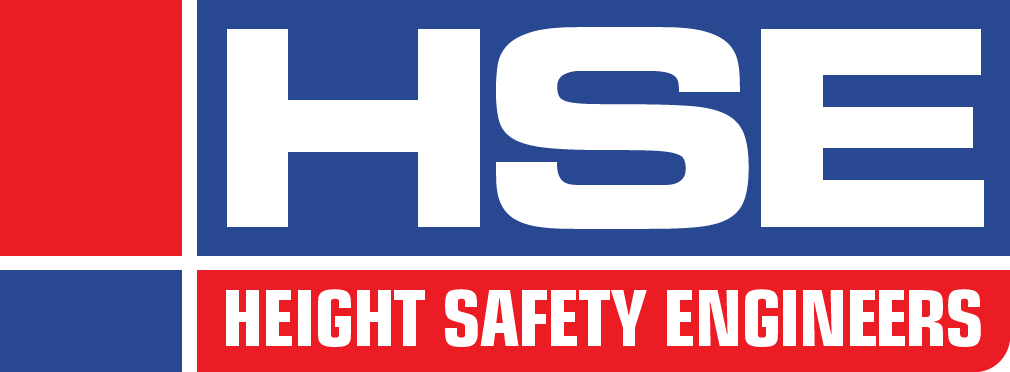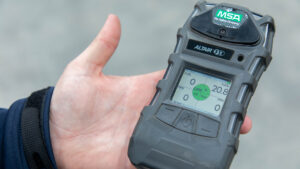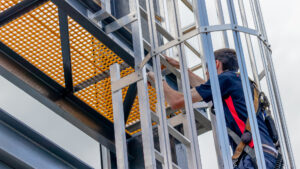To meet the duty of care as a person conducting a business or undertaking (PCBU) it is important that safe access and fall protection systems be compliant.
Maintaining a compliant height safety system is a key component of protecting workers against the risk of injury of a fall. But what is compliance, who is responsible for it and how is it achieved?
In this blog, our experts look at some important questions around height safety compliance, and what it can look like at your workplace.
Defining compliance
The Macquarie Dictionary (Ninth edition) defines compliance as: “performance, as of a business or institution, that is within government regulations”. For safety matters, this means staying within the bounds of the Work Health and Safety Act 2011 (NSW) and the Work Health and Safety Regulation 2017 (NSW).
Height Safety Engineers is based in NSW, so that is the flavour of legislation we will look at here. Other states and territories have very similar Acts and Regulations as workplace health and safety laws have been unified across the country.
The Act states it is the primary duty of care of the person conducting a business or undertaking (PCBU) to ensure, “so far as is reasonably practicable, the health and safety of: (a) workers engaged, or caused to be engaged by the person, and (b) workers whose activities in carrying out work are influenced or directed by the person, while the workers are at work in the business or undertaking.”
As part of that responsibility, the PCBU is required to provide a work environment that is without risks to health and safety, provide and maintain plant and equipment, as well as systems of safely carrying out work.
The Regulation provides a substantial list of specific hazards where the PCBU has a duty of care to manage any risks associated with that hazard. It covers risks including those associated with confined spaces, mining, diving, driving, construction work, hazardous chemicals, manual handling of materials and much more.
It also covers the risks associated with falls. Here, it states that a PCBU must manage the risks associated with “a fall by a person from one level to another that is reasonably likely to cause injury to the person or any other person”.
In many workplaces, there may be more than one PCBU, with each having different areas of responsibility and duties of care.
Role of the PCBU
Under the Work Health and Safety Act, the PCBU is the party responsible for ensuring worker safety at a workplace or job site. However, depending on the relationship between the various parties involved in completing work, and the relationships they have between each other, determining who the PCBU is at any point can be complicated.
Looking at these relationships and tiers of responsibility can be made clearer by considering the function of a contractual chain.
In short, a building owner or operator is responsible for the physical workplace being safe. When it comes to height safety, this typically involves having compliant safe access and fall protection systems installed. They are also responsible for ensuring anyone they engage to work on their site is competent to complete the work required.
A contractor or employer – such as a HVAC maintenance company or plant mechanic – has a responsibly to ensure their teams are trained adequately and provided with methods and procedures to safely carry out the work.
Australian Standards
While the Act determines who has responsibility for workplace safety, and the Regulation outlines specific risk areas that need to be considered and mitigated, Australian Standards provide specification and guidance on how these mitigations should be designed, installed, and used.
The Working at Height Association of Australian maintains a list of all the Australian standards that relate to working at height and in areas where there is risk of a fall – which includes things like confined spaces and other areas that might not be immediately obvious.
When needing to use a safety system, a worker should check that the system has been installed and maintained in accordance with the relevant Australian standards. They should also check to ensure that they are aware of what type of access the system provides.
Full access systems and restricted access systems
Height safety systems can offer two different types of access – full access or restricted access.
Full access typically allows a worker to access an entire work area safely. For example, this would be all areas of a roof, including gutters. They may need to transfer between system components, such as roof anchors or along a static line, to move across the roof, but the system is designed in such a way that a worker can remain protected against the risks of a fall regardless of where they are.
Restricted access, in comparison, only provides safe access to specific parts of a risk area. For example, a restricted access system may provide a worker with safe means to access a roof, and to transfer to a specific piece of plant (such as a lift motor) and work in that area but does not provide them with a safe means of accessing the other roof edges.
In both cases, the system can be compliant but, in the latter, it is important that any restrictions or limitations on the system’s use be documented and made known to those needing to use the system.
Checking system compliance
The main way a system’s compliance can be confirmed is to ask for the certificate of compliance that would have been issued to the owner following the most recent compliance inspection.
These regular inspections are required as part of the Australian standards (specifically, AS/NZS 1891.4, s9.1), and certificates are issued from the inspector following the inspection should the system pass.
In some cases, a system may be found to be partially compliant. In this case, a report should also have been issued outlining where the system has failed. This allows workers to identify what parts of a system are safe to use, and what components or work areas are not compliant and should not be accessed.
Discuss your height safety needs with the experts
Height Safety Engineers are the experts in providing and ensuring compliant height safety across a variety of industries and work environments. Our team have the knowledge and experience to provide your building or worksite with a compliant, best practice height safety or fall protection solution.
Discuss your safety needs with our team by calling 1300 884 978 or email enquiries@heightsafety.net.





